St. Salvation, Chebren Monastery
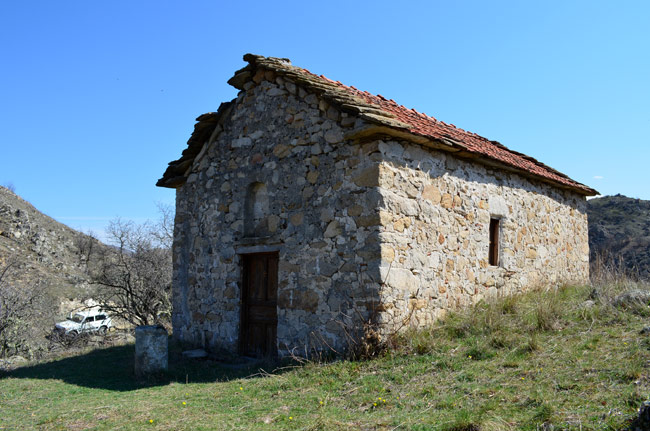
The church of St. Salvation that is near the Chebren monastery, left from the macadam road leading to the monastery, located on a hill above Crna Reka, is outside from the third defensive wall of the medieval town of Chebren.
This is a small one-nave church with dimensions of 6.30 X 4.30m. and a height of 2.80m. Terrain where the church has been built is mostly rocky. Its orientation is east-west. Entrance to the church, on one-stair, is on the west side. The opening of the entrance is a small wooden door. Above the entrance door there is a semicircular niche with remains of plaster which was probably painted in the past. There is a small rectangular hole – window in the southern façade. The east apse of the sanctuary has been built over a cliff. There is a hole – denticula at the apse. Because of the slope of the terrain the northern part of the church is higher than the south. Church has been built of cut stone and mud and the outside (facades) with grouting lime plaster.
Today cannot be ascertained on which way the original arch has been made (hemispherical or otherwise). Today the church is covered with red roof tiles, but on the edges there are still preserved slate tiles over the gable walls on north and south. Today, the nave of the church is separated from the sanctuary with simple wooden iconostasis. There were no remains from the old one. The east wall centrally ends with a semicircular apse with a depth of 0.66m and two shallow arch-like niches in the place of prothesis and diaconicum.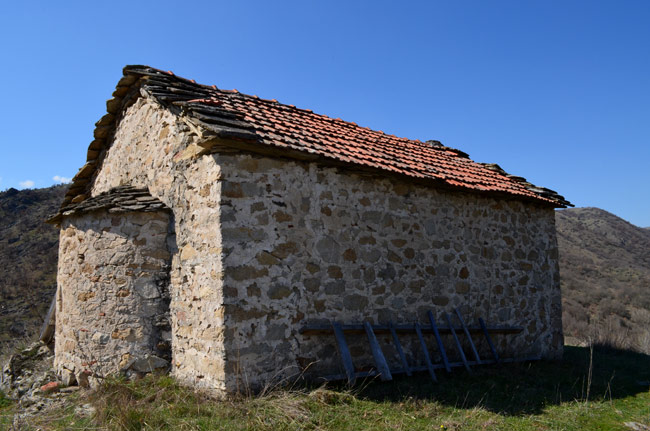
The floor of the church is made of stone tiles compacted on the ground. Church interior has been painted: north, south and west wall of the nave and in the sanctuary. The total area of wall-painting is 43m2. Painting technique probably is fresco. Light blue shades, green, toned white color in contrast of carmine, yellow ochre and brown have been used in the church painting. According to the data we have the roof and the arch as well as the whole church in a way suffered in the World War I. The current roof is a dual-pitched in combination of roof tiles and slate tiles at the apse and eastern edge of the roof. The church has been very little explored in the past, but according to the painting it is dated from the end of XV and first decades of the XVI century.
In the lower zone of the sanctuary the Eucharistic scene of Adoration of the Lamb – the service of Holy Hierarchs St. Basil the Great and St. John Chrysostom is presented. Signatures and texts are inscribed on Church Slavic. Above them in the conch of the apse Theotokos of type Shirshaja - Platitera and Jesus Christ in medallion are presented. In the niche of the prothesis St. Stephen the Protomartyr is painted, while in the niche of the diaconicum St. Roman is painted. Between them the Old Testament’ prophets, David, St. Simeon the Stylite are presented.
In the lower part of the baseboard of eastern wall draped curtain has been painted in white and carmine red and ochre lines and tiny flowers. On the northern wall of the sanctuary the scene – Vision of Peter from Alexandria is where the infant Christ is presented standing over a rectangular table covered with a sheet, Peter of Alexandria with opened scroll and on the grounds, Arius, the heretic.
Note. We learn about Peter of Alexandria from the hagiographical texts for the month of November (25). Peter was a bishop of Alexandria in 311, when he was arrested by Roman Emperor Maximilian and then executed. One day before the execution, he had a vision during worship service when Christ appeared and told him not to receive Arius the heretic in Christian community, nor to communicate him. Moreover, according to the tradition, Jesus showed his chiton which Arius had torn. Arius was flagship of the Arian heresy, which was abolished at the First Ecumenical Council in Nicaea in 325.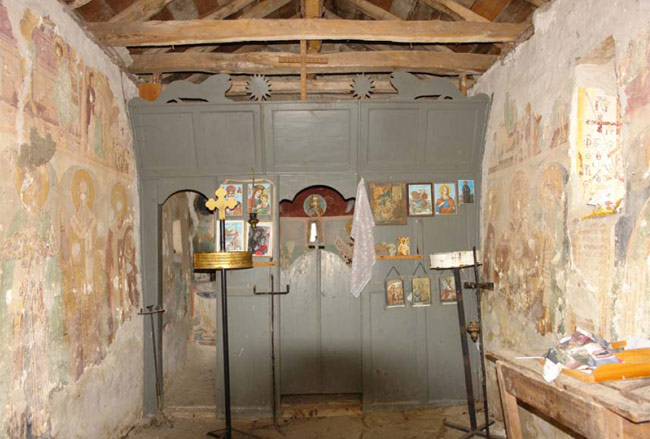
The interior of the church from the eastern entrance

The interior of the church from east to west
In mid-14th century the vision of Peter of Alexandria gets closer to the scene Service of the Hierarchs of Christ – the Lamb. Such is the case in this church and in the Ohrid painting by 14th century (Theotokos of Zaum, Theotokos Peribepta –the Metropolis of Mistra, St. Nicholas in Melnik - Bulgaria, Grachanica, Saint Nicholas in Varosh, Saint Nicholas in Manastir and others). This scene started to be used for decorating the temples from 12th century. The scene of Peter of Alexandria’s vision in this church is characteristic that Peter holds an open scroll, which is not the case in other presentations of this scene, then Christ is represented hovering over the sacred table rounded elliptically in white light, while Arius is not represented with his head down, but as a witness to the vision of Peter.
Cross and cryptogram on the west
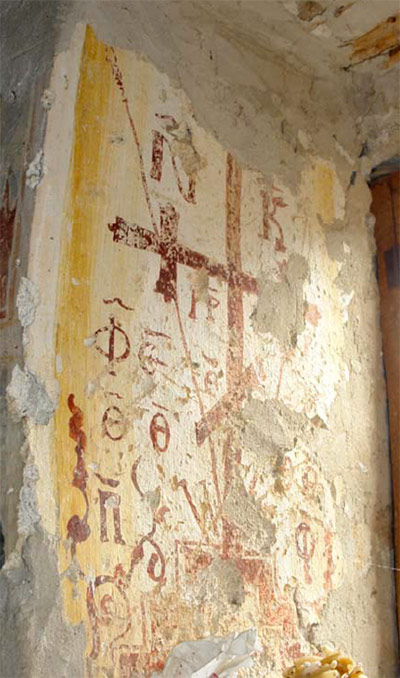
Cross and cryptogram at the east window in the south wall
In the second zone above this scene partially preserved scene of Christ's Ascension is presented. Saint Spyridon and St. Cyril of Alexandria are presented in the lower zone of the sanctuary at the south wall. The painting of Jesus Christ the King and Great Hierarch with Theotokos Paraclisa (Molbenica) from the right side and John the Baptist from the left in on the south wall in the nave, at the first zone. Both hold open scrolls.
Note. Depiction of Jesus Christ the King and Great Hierarch, next to the altar compartment has own meaning (willingness to offer as eucharistic sacrifice and in all its glory). In older literature this scene is known as the "Royal Deisis". The oldest known composition of this kind is depicted in the northern dome of the narthex of the monastery church of the Assumption of Theotokos in Treskavec nearby Prilep around in 1340. The inscription in Chruch Slavic text is below the window. In the inside of the walls of the window on both sides crosses in carmine red and cryptograms are painted. Cryptograms have meaning.
In the first zone of the south wall in continuation St. Panteleimon and holy warriors St. Theodore Tyron and Stratilat are painted. Below the southern wall in the first zone is shown St. Panteleimon and holy warriors St. Theodore Tyron and Stratilat. The warriors are not dressed in their usual army clothes, but in ceremonial dignitary clothes. We cannot identify with certainty the scenes in the second zone, but probably scenes from the Great Feasts and Christ’s passions are painted, as recognized the scenes in the second strip over the holy warriors - the resurrection of Lazarus and the first scene starting from the altar partition which is probably Annunciation of the Virgin.
In the lower zone on the west side of the southwest the Archangel Michael is presented in full size.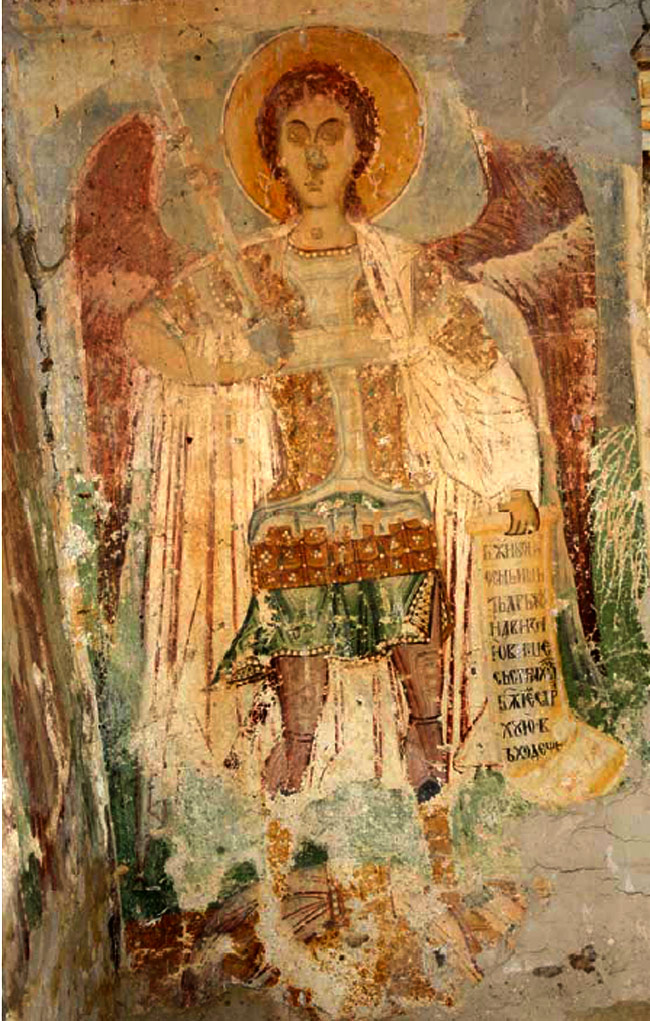
Archangel Michael, presentation on the west wall
The archangel’s figure is disproportionate compared to the dimension of the space. He is depicted holding a sword in the right hand and opened scroll in the left in decisive stand and whirling wings. Yellow ochre, brown, blue-gray, green and tone while have been used for painting. Opposite him, on the same wall to the northwest in the lower zone St. Constantine and Helene in full size with the Holy Cross – the symbol of the Christian faith. They are dressed in ceremonial royal attires with crowns on the heads. St. Constantine and St. Helene’s figures are in the upper part of the painted arches in tone white, while the background is pastel blue-gray. Their robes are painted carmine red, while the cloaks are in tone white. On the west wall above the door in the second zone the scene of Assumption of Mary has been painted. A group of Apostles putting hands on the deathbed are getting closer to Theotokos from the right side and she is surrounded around the deathbed by the other apostles, hierarchs that attended the event. Holy hierarchs are painted in separate fields on southwest and northwest from the scene.
The Holy Unmercenaries Cosmas and Damian, Warrior St. George, Warrior St. Demetrius, St. Athanasius and St. Nicolas are painted on the north wall of the nave in the first zone starting from the altar partition. Saints are depicted in full size wearing ceremonial dignitary attires.
Scenes of Jesus Christ’s life - Great Feasts, even though partially preserved, are recognized in the second zone; starting from the altar partition: Palm Sunday or Entering of Jesus in Jerusalem, then the scene of Christ’s Crucifixion and the scene of Myrrh-Bearing Women to the Christ’s tomb.
Note the scene of Christ’s crucifixion which takes place on the Golgotha hill deviates from the conventional presentation. The action of this scene takes place in a different, brighter environment with urban architectural elements painted in the background.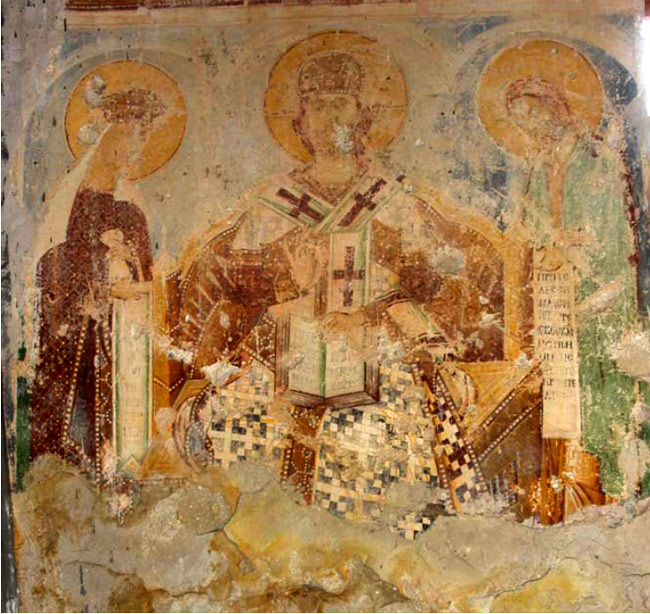
Scene of Jesus Christ Great Hierarch and King and Theotokos Paraklisa Molbenica

The scene of the vision of Peter of Alexandria in the prothesis

The inscription below the window on the south wall of the nave
The perfectly painted decoration in the church of St. Salvation contains thematic innovations: the Vision of Peter of Alexandria and Jesus Christ the King and Theotokos the Queen that were presented in XIII and XIV century giving special feature of the last centuries of the Palaiologos dynasty Byzintine style. The range of color and manner of???? makes us more known the wall-painting of the church of St. Salvation; identification of the artistic handwriting.
Architecture and painting of the church are in a very poor condition, with damages of risky and critical type. Especially the damages on wall-painting heavily contributed to its disintegrated appearance overall.
Text: Olivera Makrievska









